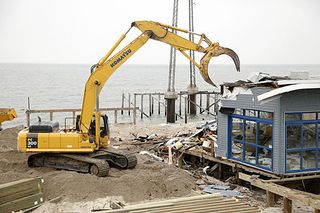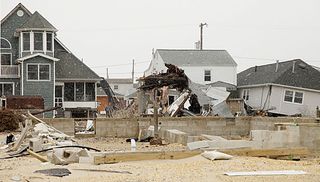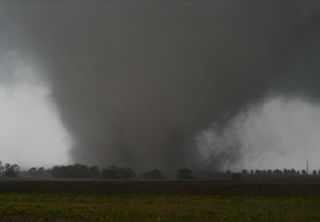
Post Sandy: The Jersey Shore's Susceptibility to Major Storms

This article was provided by AccuWeather.com.
Before Superstorm Sandy made landfall on the Jersey coast on Oct. 29, 2012, few realized the intensity of the storm that headed in their direction.
The National Hurricane Center opted not to issue hurricane warnings north of North Carolina, and instead handed the reins to regional National Weather Service offices.
Local governments warned the public of the approaching threat, and issued evacuation orders to many towns. While some residents agreed to leave, others resisted, believing that people were 'crying wolf' about the storm.
Sandy, later dubbed a superstorm, brought wind gusts as high as 78 miles per hour to parts of New Jersey. The total inundation* along the New Jersey coast ranged from 9 to 13 feet, causing breaching and erosion to sand dunes and resulting in severe flooding to homes and businesses.
Could the inflicted damage to the coastline have been avoided with advance preparation?
Daniel Barone of the Coastal Research Center (CRC) at The Richard Stockton College of New Jersey has spent years studying the dunes of the Jersey coast. The CRC has completed full assessments of the dunes in Ocean and Atlantic counties.
Sign up for the Live Science daily newsletter now
Get the world’s most fascinating discoveries delivered straight to your inbox.
"There were plenty of areas that were a cause for concern before Sandy, and still are," Barone said. "Even before the storm, we knew of several places in northern Ocean County and Long Beach Island that would not withstand even a 20-year storm, based on our results."
Though Barone could not compare New Jersey's level of preparedness to another coastal state, he would say that New Jersey is "one of the most proactive states in the nation in doing beach replenishment projects."

Beach replenishment projects were implemented in some areas of concern before Sandy, and it prevented a significant amount of damage, Barone said, noting Harvey Cedars, N.J.
Prior to Harvey Cedars' beach replenishment initiative, the CRC's analysis indicated that there were areas with high potential for breach and overwash in a 50-year storm scenario.
The initiative sought to restore areas which were considered to be at risk.
"While some areas did breach and overwash in the southern side of the town, even with the replenishment, the majority of the town was spared the full brunt of Sandy's power from ocean waves," Barone said.
Harvey Cedars suffered catastrophic damage after the March storm of 1962 due to breaching and overwash. The CRC's assessment data shows that the town was one of the most vulnerable locations on Long Beach Island.
"Had they not had that project, it is very likely that the town would have sustained far more damages to homes and infrastructure due to ocean waves crossing over land," Barone said.
Harvey Cedars was only one of many areas along the coast which have worked to decrease its susceptibility. Midway Beach in northern Ocean County and Ship Bottom, N.J., have spent decades trying to naturally increase the size of their dunes, he said.
"If you look at the before and after aerial images from Sandy, you can see that their efforts paid off," Barone said.
RELATED: Sandy-Ravaged Businesses Prepare for Tourism; Residents Fear Public Confusion WATCH: The Road to Recovery After Superstorm Sandy
While dunes do not eradicate all risk, they have proven effective in many areas. Despite this, some towns have opted not to install the barriers in areas that would see benefit from them.
"Places like Point Pleasant Beach, in front of their boardwalk, or even in Seaside, they did not have a dune," Barone said. "They had a very wide beach but a wide beach isn't enough in some cases, especially when you have the surge and wave energy that Sandy had."
The absence of dunes, however, is not due to a lack of awareness from government officials. In some cases, objection has come from oceanfront property owners who cite that the dunes are an eye sore and decrease the value of their homes.
In mid-January Gov. Chris Christie spoke out against these objections calling them "selfish" and "short-sighted."
But, even if dunes were to be installed through the length of Jersey's coast, they will not eradicate the flood risk completely, nor will they be a solution for barrier islands.
Homes built along the bay are vulnerable from both sides.
"Back bay flooding from storm surge and astronomically high tides is something that can occur regardless of having a significant beach-dune system to stop ocean waters from crossing an island," Barone explained.
Now, months since Sandy wreaked havoc on the coastline, the focus has shifted to the process of rebuilding. Devastation along the coast remains widespread, as business owners and homeowners struggle to make reparations in accordance with new FEMA, insurance and flood zone regulations.

For some flood zones, in accordance with recent changes, FEMA has proposed raising homes as high as 10 feet.
Many buildings on the coast have sustained severe flood damage to the first level of their homes. This regulation would eliminate the need to gut and rebuild an entire first floor should another major flooding event occur.
New regulations are designed to decrease the town's susceptibility to future natural disasters, but will result in significantly higher costs to rebuild for business and homeowners.
"Residents should mimic the storm surge from Sandy, and they should build as if that storm surge could happen again tomorrow," AccuWeather.com Expert Senior Meteorologist Dan Kottlowski said.
"That would be the smart thing to do, and actually that would be the most economical thing to do. Even if something doesn't happen in the next five to 10 years, 15 years from now it could still happen."
However, the argument exists that a storm of this intensity will not occur again for many years, if ever. Some have begun to refer to it as the "perfect storm."
In some ways, it was, according to James Franklin, Branch Chief for the National Hurricane Center's Hurricane Specialist Unit.
"It was a perfect storm in the sense that you had just the wrong steering flow coupled with very strong extratropical forcing that led to a large cyclone of hurricane strength plowing directly onshore into an area that normally gets glancing blows," Franklin said. "But if it happened once it clearly can happen again, even if it's very unlikely."
The likelihood of a recurrence of this magnitude remains debatable in the scientific community. Some uphold that this scenario does, in fact, hold a 1 percent chance of recurrence, but others insist that changing environmental factors could increase the coast's susceptibility.
"With global sea level rise predictions estimating 2 to 4 feet over the next century, we need to start being proactive as opposed to reactive," Barone said.
"They need to plan for the future. You can't just kick the can down the road."
A recent report by the U.S. Geological Survey concluded that the mid-Atlantic coast of the United States is a "hot spot" for sea level rise, and that water levels in this area could be three to four times higher than the global average.
This rise in sea level could "increase the vulnerability of coastal cities to flooding, and beaches and wetlands to deterioration," according to the report.
Experts agree that regardless of the likelihood of another superstorm, advance preparation will pay off in the long run.
"Raising properties above flood elevations and improving infrastructure as well as ways to manage storm waters is going to be essential for sustainability of these communities in the future, in addition to maintaining beaches," Barone said.
"If these places are not maintained, there is potential for them to become inundated in the future and drown in place."
*Total inundation refers to the total height of the water during a storm. This would include storm surge, tides and any other factors that would cause water levels to rise.
© AccuWeather.com. All rights reserved. More from AccuWeather.com.
The only sure thing about weather forecasts is that they’re wildly different all over the planet. Test your knowledge on the wild ranges in temperature, precipitation and more.
Extreme Weather Facts: Quiz Yourself













